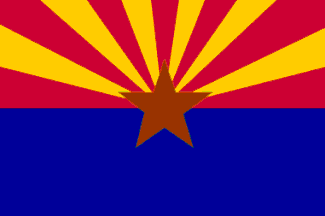 image by Mario Fabretto, 24 February 1998
image by Mario Fabretto, 24 February 1998

Last modified: 2006-08-26 by rick wyatt
Keywords: arizona | united states |
Links: FOTW homepage |
search |
disclaimer and copyright |
write us |
mirrors
 image by Mario Fabretto, 24 February 1998
image by Mario Fabretto, 24 February 1998
County flags:
See also:
In 1912, two stars were added, representing Arizona and New Mexico, bringing the total number of stars on the U.S. flag to 48. There were thirteen stripes representing the thirteen original colonies.
The lower half of the flag is a blue field, the upper half divided into thirteen equal segments, six light yellow and seven red. In the center of the flag is a copper-colored five-point star. The red and the blue are the same shades as the flag of the United States of America, and it measures four feet high and six feet wide. The flag was designed by Charles W. Harris and first sewn by Nan D. Hayden. Blue and yellow are the Arizona colors, and red and yellow the colors of the Spanish Conquistadors headed by Coronado who first came to Arizona in 1540. The copper star represents Arizona as the
largest producer of copper in the nation.
Chris Young, 2 August 1999
The flag of Arizona was only adopted after much debate, since some felt that the notion of sun rays from a star was "astronomically improbable."
Josh Fruhlinger, 12 February 1996
Arizona Revised Statutes
41-851.B. The flag of the state shall be of the following design:
The lower half of the flag a blue field and the upper half divided into thirteen equal segments or rays which shall start at the center on the lower line and continue to the edges of the flag, colored alternately light yellow and red, consisting of six yellow and seven red rays. In the center of the flag, superimposed, there shall be a copper-colored five pointed star, so placed that the upper points shall be one foot from the top of the flag and the lower points one foot from the bottom of the flag. The red and blue shall be the same shade as the colors in the flag of the United States. The flag shall have a four-foot hoist and a six-foot fly, with a two-foot star and the same proportions shall be observed for flags of other sizes.41-851.C. The flag represents the copper star of Arizona rising from a blue field in the face of a setting sun.
Apparently the state flag was not adopted immediately upon achieving statehood, which is common. Arizona became a state in 1912 but did not adopt its flag until 1917.
Nathan Augustine, 12 February 1996
Chronology:
azmil.gif) image by Joe McMillan, 21 April 2000
image by Joe McMillan, 21 April 2000
The state military crest, which is the crest used in the coats of arms of units of the National Guard, as granted by the precursor organizations of what is now the Army Institute of Heraldry. The official Institute of Heraldry blazon is
"A giant cactus proper."
Joe McMillan, 21 April 2000